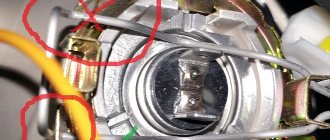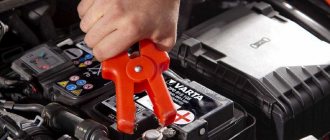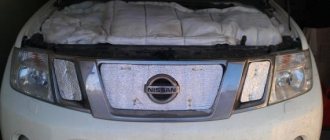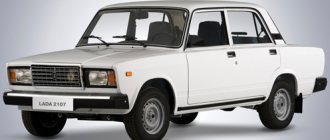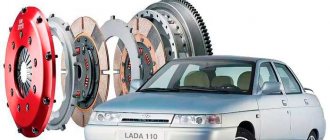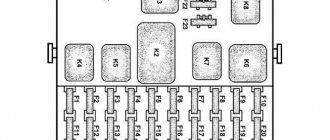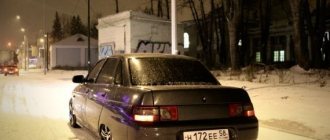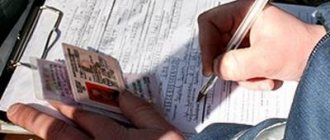First of all, let's turn to the main road law - the Rules of the Road. So, paragraph 19.5 reads: “ During daylight hours, low-beam headlights or daytime running lights must be turned on on all moving vehicles for the purpose of identifying them.”
At the same time, the Rules clearly allow for one possibility of replacing the low beam - clause 19.4. allows the use of fog lights instead of low beam headlights.
Thus, during the day you should have either low-beam headlights, fog lights, or daytime running lights on in front. There is no mention in the traffic rules that there are enough side lights during the day.
Fine for driving without headlights at night
At night, drivers must turn on low or high beams in their cars.
High beams can be used on the highway to see the road in front of you, but you cannot:
- in populated areas with lighting lamps along the road;
- in front of another car that is moving in the opposite direction. According to the rules, high beams are turned off 150 meters before approaching, or earlier if the driver of an oncoming car blinks his headlights;
- when driving behind another car, so as not to blind the driver through the rear view mirror.
If your car is equipped with spotlights or searchlights, they can also be used only outside the city, when there are no oncoming cars.
If the car is parked on the side of the road at night, the driver must turn on the headlights and may additionally use other headlights.
Fine for driving high beams in the city
Another popular rule violation is improper use of high beam headlights. High beam cannot be used:
- in populated areas on illuminated roads;
- when passing oncoming traffic with another car (at a distance of less than 150 meters);
- in other cases, if it can blind drivers of passing or oncoming cars.
Most often, a fine is imposed specifically for using high beams in the city. It represents a warning or 500 rubles .
How to avoid a fine for driving without headlights
Turn on the light immediately. The easiest way to avoid paying a fine for headlights is to get into the habit of turning on the low beam automatically as soon as you start the engine. With your headlights on, the inspector will have no reason to fine you.
The headlights do not work - turn on the fog lights. Daytime running lights or front fog lights can be used instead of low beams. This is also legal.
If caught, fix the problem immediately. If the inspector stopped you for unlit or dirty headlights, try to agree that you will correct the violation on the spot - turn on the lights or wipe the headlights. According to the law, a traffic police officer has the right to limit himself to a warning and not issue a fine.
Changing something good only spoils it
“Now the old rules continue to apply; no new amendments to the traffic rules regarding lighting devices have been adopted,” says Pyotr Shkumatov. But there is one point hidden in the traffic rules, around which the controversy began.
The fact is that the latest amendments to paragraph 19.5 of the traffic rules were approved in 2010. They have significantly tightened the rules for the use of lighting devices on vehicles. If previously passenger cars were required to drive during the day with lights only outside the city, then in the new edition of the traffic rules this has become mandatory within populated areas. Meanwhile, 8 years ago there was some relaxation. It was allowed to use daytime running lights instead of low beam headlights. The literally edited clause 19.5 of the traffic rules read: “During daylight hours, low-beam headlights or daytime running lights must be turned on on all moving vehicles for the purpose of identifying them.”
Apparently, the addition “or daytime running lights” has caused so many discrepancies and interpretations. Some drivers thought that instead of bright low beams during the day, they could limit themselves to dim headlights. What does this lead to?
Is it possible to cut a turn through a solid road and how to avoid deprivation of rights? More details
Remember
- During the day, use low beams, running lights or front fog lights. At night - low or high beam.
- The high beam must be turned off on illuminated roads and when approaching other cars.
- The front fog lights can always be used, the rear ones can only be used when visibility is poor.
- The fine for not turning on headlights or incorrect use of lights on the road is 500 rubles.
- This fine can be paid at a discount in the first 20 days.
All articles by the author: Ilya Novikov
Use of external lighting devices during the day
Clause 19.5 of the Russian Traffic Regulations states that in clear weather and good visibility during the day, low beam headlights must be turned on on all vehicles, and side lights on trailers and towed vehicles .
According to paragraph 19.4 of the Russian Traffic Regulations , instead of low-beam headlights, fog lights or daytime running lights, if available, can be used.
Failure to comply with clause 19.5 is punishable by a fine of 500 rubles, but in most cases everything can be done with a verbal warning to the driver from the traffic police.
Paragraph 19.1 of the traffic rules - passage of tunnels . Regardless of whether it is well lit or not, the traffic rules require turning on low or high beam (if there are no oncoming cars) headlights inside it at the entrance. If, before entering the tunnel, only your running lights or fog lights were on, switch to low-beam headlights and turn them off only when you exit.
Often in the daytime visibility deteriorates due to the weather - rain, snow, fog, or simply darkness due to clouds blocking the sun. In the rules in paragraph 1.2, this is described as “insufficient visibility” - when less than 300 meters of the road is visible in conditions of precipitation or twilight.
This should not be confused with limited visibility, when visibility on the road is obstructed by terrain, buildings, roadway geometry, or other vehicles. Also, do not confuse poor visibility with darkness.
Driving when there is insufficient visibility on the road (in fog, rain, snow) In these cases, clause 19.1 of the traffic rules requires the use of low and high beam lighting devices. Additionally, you can turn on the front fog lights, but this is not necessary.
When can rear fog lights be used? Clause 19.7 states that they can only be turned on when visibility is insufficient . The rest of the time this is prohibited - they shine very brightly and can interfere with other road users. Also, you cannot turn them on together with the brake lights.
Forced stop on the road in rain, fog, snowstorm or dust storm. Turn on your side lights so you can be seen early. Additionally, you can use low beam and fog lights - the traffic rules allow this.
The rules specified in paragraphs 3-5 of Article 19
When parking or stopping, according to paragraph 3, at night, when driving along a poorly lit highway or in a situation where visibility drops to 300 m, you simply need to use red side lights. In the latter case, it is permissible to accompany the operation of the side headlights with low beam and fog lights, front or rear.
More precise rules regarding fog lights are discussed in paragraph 4 of the current rules. If you find yourself in a situation in which visibility is significantly reduced due to weather conditions, then turn on the fog lights and, along with them, low or high beams. This also applies to driving on an unlit road at night.
According to point 5, in the daytime, no matter where you are driving, in the city or on the highway, when visibility is good, the DRLs or headlights should always be on in low beam mode.
Table for the use of external lighting devices on roads
| Conditions / Light | Daylight time | Night time, on illuminated sections of roads in populated areas | Night time on unlit road sections | Tunnel | Insufficient visibility |
| Low beam | + | + | + | + | + |
| High beam | — | — | + | + | + |
| Fog lights | 1 | — | 2 | — | 2 |
| Daytime Running Lights | 1 | — | — | — | — |
| Rear fog lights | — | — | — | — | + |
- “1” - Instead of low beam headlights;
- “2” - Only in combination with low and high beam headlights.
Rules for using external lighting devices at night
At night, or the dark time of the day, the rules refer to the period of time between the end of the evening and the beginning of the morning twilight.
In such conditions, it is mandatory to turn on the headlights and side lights. The choice of low or high beam depends on the following nuances:
- If you are driving along illuminated roads in a populated area , you cannot use high beams, only low beams.
- When approaching a vehicle moving in the oncoming lane, the high beams should be switched to low beams at least 150 meters in advance - this way you will not blind the other driver. It’s even better to switch at 200-250 meters.
- If an oncoming vehicle signals by switching or flashing its headlights at a greater distance , turn off the high beams. In such situations, your headlights are most likely poorly adjusted, and they do not so much illuminate the road as they shine into the eyes of oncoming drivers.
- You also need to switch the lights in other situations when there is a threat of blinding other drivers , both oncoming and passing.
What to do if you are blinded? The main thing is not to change lanes, otherwise there is a risk of getting into an accident, hitting a pedestrian or falling into a ditch. The rules require in such a situation to turn on the hazard warning lights, gradually reduce speed and, if necessary, stop.
Forced stop in the dark - be sure to turn on the side lights and, if desired, supplement them with low beams and fog lights.
What the law says
In accordance with Russian legislation, you should only drive a passenger car with low beam headlights on at any time of the day, regardless of weather conditions. This requirement must be met both in populated areas and when driving on country highways.
The speed of modern cars has increased significantly, so in many cases, overtaking requires a section of road up to 500 meters long. At such a distance, oncoming cars can be difficult to distinguish. Sun glare and dark body color complicate the task.
Without low beams on, the car is difficult to see in the rearview mirror. Turning on the headlights completely solves this problem. In this case, the side lights that are turned on can be considered completely useless, since they are significantly inferior in brightness and cannot be seen from afar. Modern foreign-made cars are equipped with daytime running lights, which in brightness can be compared with low beam headlights.
Paragraph 19.5 of the traffic rules requires driving during the day with low beam headlights or running lights on. For driving only with the lights on and without headlights, according to Article 12.20 of the Code of Administrative Offenses of the Russian Federation, administrative liability is provided in the form of a fine of 500 rubles.
Lighting devices - other features of use
Another type of automotive lighting is a spotlight or searchlight .
This is a device that produces a powerful and bright beam of light that can be directed in the desired direction. It is used only outside the city (especially off-road) and provided that there are no oncoming vehicles whose drivers may be temporarily blinded by the spotlight. In the city, such lighting equipment is used only by emergency vehicles. And for road trains, the rules provide for a special identification mark in the form of three orange lights on the roof of the vehicle cabin. When driving, it should always be on, and at night or when visibility is insufficient, the sign should also work during stops and parking.
There is also a “rule of good manners” that is not regulated in the traffic rules. If you drive past a traffic police post, a car accident or another unusual situation on the road, warn oncoming drivers by flashing your headlights.
It is also considered polite on the road not to use high beams and rear fog lights unless absolutely necessary - they shine too brightly and often blind other drivers. But these rules, unlike the previous one, are already enshrined in the traffic rules.
Video lesson: rules for using external lighting devices and sound signals.
What light to use when visibility on the road is poor
For those who travel by car every day, the most common troublemakers are: morning fog, heavy snowfall, rain and twilight. To increase traffic safety, you can operate the headlights in both high beam and low beam modes. Here we would like to draw your attention to the fact that poor visibility due to weather and night time are different conditions, according to traffic regulations. Therefore, it is necessary to use high beams at night and in poor visibility conditions in accordance with established rules.
Poor visibility conditions are those that limit the driver's vision to less than 300 m ahead. If in such a situation you decide to stop driving, you can turn on the headlights together with the fog lights or low beam headlights. Or turn on the fog lights together with high or low beams plus rear fog lights.
Accordingly, it would be a violation to use fog lights without low or high beams, and this also includes included DRLs.

